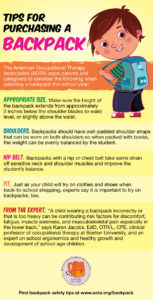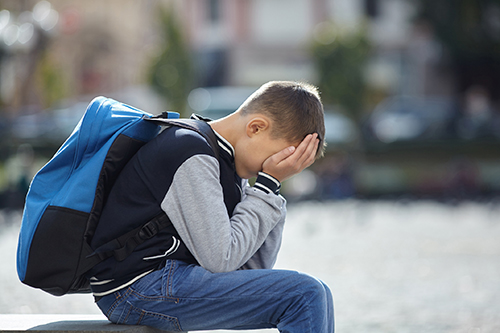A proper fitting backpack is a good way to prevent physical pain and promote wellness. Unfortunately, over half of students carry backpacks over the recommended weight or wear it the wrong way, which can lead to pain and strain.
Few parents actually check the weight of their children’s backpacks, so we want to raise awareness about proper backpack habits for National Backpack Awareness Day.
Did you Know …
 Heavier books should be packed toward the child’s back
Heavier books should be packed toward the child’s back- The weight of the backpack should be equal to no more than 10% of the child’s body weight
- Straps should be tight and supported by the child’s body
- If available, hip belts and chest straps should be fastened
- The lower part of the backpack should rest no lower than 4 inches below waistline
Here’s how you can help your children load and wear backpacks the correct way to avoid health problems.
Loading a Pack
- A child’s backpack should weigh no more than about 10% of his or her body weight. This means a student weighing 100 pounds shouldn’t wear a loaded school backpack heavier than about 10 pounds.
- Load heaviest items closest to the child’s back (the back of the pack).
- Arrange books and materials so they won’t slide around in the backpack.
- Check what your child carries to school and brings home. Make sure the items are necessary for the day’s activities.
- If the backpack is too heavy or tightly packed, your child can hand carry a book or other item outside the pack.
- If the backpack is too heavy on a regular basis, consider using a book bag on wheels if your child’s school allows it.
Wearing a Pack
- Distribute weight evenly by using both straps. Wearing a pack slung over one shoulder can cause a child to lean to one side, curving the spine and causing pain or discomfort.
- Select a pack with well-padded shoulder straps. Shoulders and necks have many blood vessels and nerves that can cause pain and tingling in the neck, arms, and hands when too much pressure is applied.
- Adjust the shoulder straps so that the pack fits snugly on the child’s back. A pack that hangs loosely from the back can pull the child backwards and strain muscles.
- Wear the waist belt if the backpack has one. This helps distribute the pack’s weight more evenly.
- The bottom of the pack should rest in the curve of the lower back. It should never rest more than four inches below the child’s waistline.
- School backpacks come in different sizes for different ages. Choose the right size pack for your child as well as one with enough room for necessary school items.
Watch Karen Jacobs, clinical professor at Boston University’s Sargent College of Health and Rehabilitation Sciences and an occupational therapist, offers tips on how to choose the best backpack and how to pack and wear backpacks to help reduce back, neck and shoulder pain.





